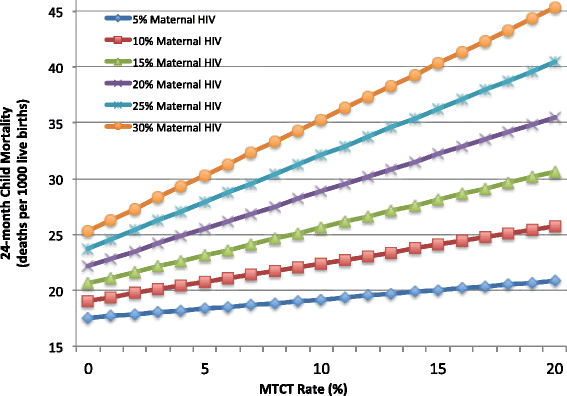HIV-exposed children account for more than half of 24-month mortality in Botswana
- PMID: 27439303
- PMCID: PMC4955224
- DOI: 10.1186/s12887-016-0635-5
HIV-exposed children account for more than half of 24-month mortality in Botswana
Abstract
Background: The contribution of HIV-exposure to childhood mortality in a setting with widespread antiretroviral treatment (ART) availability has not been determined.
Methods: From January 2012 to March 2013, mothers were enrolled within 48 h of delivery at 5 government postpartum wards in Botswana. Participants were followed by phone 1-3 monthly for 24 months. Risk factors for 24-month survival were assessed by Cox proportional hazards modeling.
Results: Three thousand mothers (1499 HIV-infected) and their 3033 children (1515 HIV-exposed) were enrolled. During pregnancy 58 % received three-drug ART, 23 % received zidovudine alone, 11 % received no antiretrovirals (8 % unknown); 2.1 % of children were HIV-infected by 24 months. Vital status at 24 months was known for 3018 (99.5 %) children; 106 (3.5 %) died including 12 (38 %) HIV-infected, 70 (4.7 %) HIV-exposed uninfected, and 24 (1.6 %) HIV-unexposed. Risk factors for mortality were child HIV-infection (aHR 22.6, 95 % CI 10.7, 47.5 %), child HIV-exposure (aHR 2.7, 95 % CI 1.7, 4.5) and maternal death (aHR 8.9, 95 % CI 2.1, 37.1). Replacement feeding predicted mortality when modeled separately from HIV-exposure (aHR 2.3, 95 % CI 1.5, 3.6), but colinearity with HIV-exposure status precluded investigation of its independent effect. Applied at the population level (26 % maternal HIV prevalence), an estimated 52 % of child mortality occurs among HIV-exposed or HIV-infected children.
Conclusions: In a programmatic setting with high maternal HIV prevalence and widespread maternal and child ART availability, HIV-exposed and HIV-infected children still account for most deaths at 24 months. Lack of breastfeeding was a likely contributor to excess mortality among HIV-exposed children.
Keywords: Breastfeeding; Child mortality; HIV-exposed uninfected; HIV-infected children; PMTCT; Sub-Saharan Africa.
Figures


References
-
- Mahy, M. Measuring child mortality in AIDS infected countries. Presented at the workshop on HIV/AIDS and Adult mortality in developing countries, Sept 4, 2003. Published online at: http://www.un.org/esa/population/publications/adultmort/UNICEF_Paper15.pdf. Accessed 18 July 2016.
-
- UNICEF/WHO/The World Bank/UN Pop Div. Levels and Trends in Child Mortality. Report 2013. WHO. Botswana neonatal and child health profile. Published online at http://www.who.int/maternal_child_adolescent/epidemiology/profiles/neona.... Accessed 18 July 2016.
-
- Thior I, Lockman S, Smeaton LM, Shapiro RL, Wester C, Heymann SJ, et al. Breastfeeding plus infant zidovudine prophylaxis for 6 months vs formula feeding plus infant zidovudine for 1 month to reduce mother-to-child HIV transmission in Botswana: a randomized trial: the Mashi Study. JAMA. 2006;296:794–805. doi: 10.1001/jama.296.7.794. - DOI - PubMed
Publication types
MeSH terms
Substances
Grants and funding
LinkOut - more resources
Full Text Sources
Other Literature Sources
Medical

